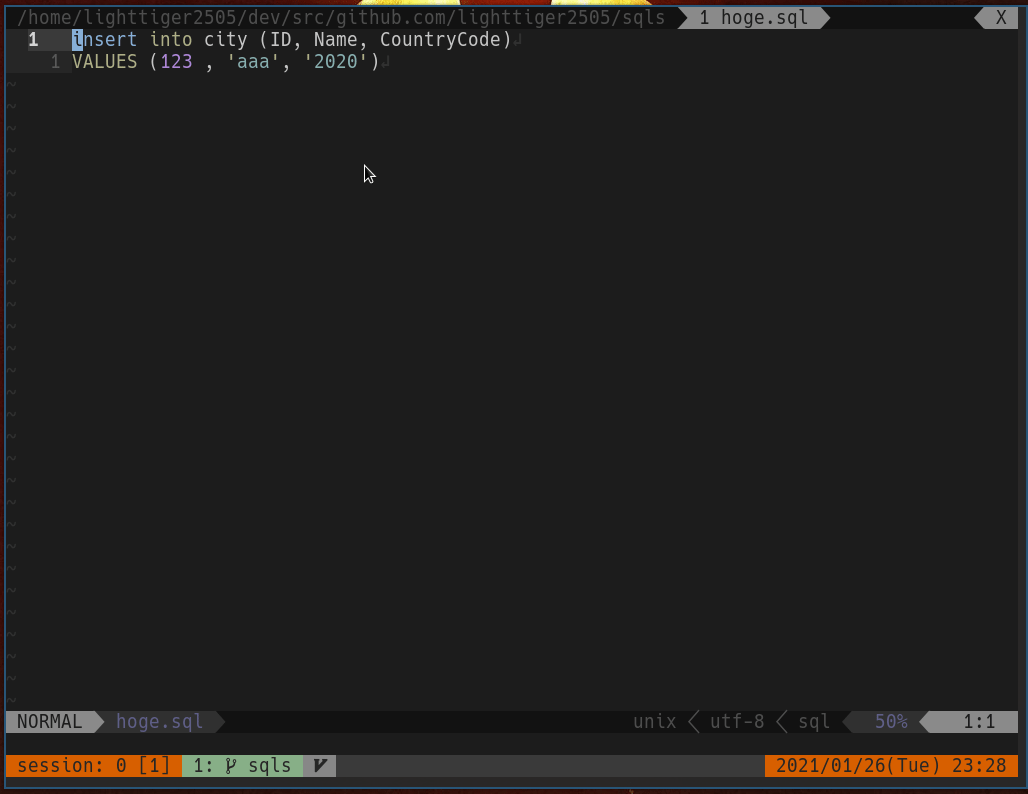An implementation of the Language Server Protocol for SQL.
This project is currently under development and there is no stable release. Therefore, destructive interface changes and configuration changes are expected.
sqls aims to provide advanced intelligence for you to edit sql in your own editor.
- MySQL(Go-MySQL-Driver)
- PostgreSQL(pgx)
- SQLite3(go-sqlite3)
- MSSQL(go-mssqldb)
- H2(pgx)
- Vertica(vertica-sql-go)
- DML(Data Manipulation Language)
- SELECT
- Sub Query
- INSERT
- UPDATE
- DELETE
- SELECT
- DDL(Data Definition Language)
- CREATE TABLE
- ALTER TABLE
If the tables are connected with a foreign key sqls can complete JOIN statements
- Execute SQL
- Explain SQL
- Switch Connection(Selected Database Connection)
- Switch Database
go install github.com/sqls-server/sqls@latestThe connection to the RDBMS is essential to take advantage of the functionality provided by sqls.
You need to set the connection to the RDBMS.
There are the following methods for RDBMS connection settings, and they are prioritized in order from the top. Whichever method you choose, the settings you make will remain the same.
- Configuration file specified by the
-configflag workspace/configurationset to LSP client- Configuration file located in the following location
$XDG_CONFIG_HOME/sqls/config.yml ("$HOME/.config" is used instead of$XDG_CONFIG_HOMEif it's not set)
# Set to true to use lowercase keywords instead of uppercase.
lowercaseKeywords: false
connections:
- alias: dsn_mysql
driver: mysql
dataSourceName: root:root@tcp(127.0.0.1:13306)/world
- alias: individual_mysql
driver: mysql
proto: tcp
user: root
passwd: root
host: 127.0.0.1
port: 13306
dbName: world
params:
autocommit: "true"
tls: skip-verify
- alias: mysql_via_ssh
driver: mysql
proto: tcp
user: admin
passwd: Q+ACgv12ABx/
host: 192.168.121.163
port: 3306
dbName: world
sshConfig:
host: 192.168.121.168
port: 22
user: sshuser
passPhrase: ssspass
privateKey: /home/sqls-server/.ssh/id_rsa
- alias: dsn_vertica
driver: vertica
dataSourceName: vertica:https://user:pass@host:5433/dbname- setting example with vim-lsp.
if executable('sqls')
augroup LspSqls
autocmd!
autocmd User lsp_setup call lsp#register_server({
\ 'name': 'sqls',
\ 'cmd': {server_info->['sqls']},
\ 'whitelist': ['sql'],
\ 'workspace_config': {
\ 'sqls': {
\ 'connections': [
\ {
\ 'driver': 'mysql',
\ 'dataSourceName': 'root:root@tcp(127.0.0.1:13306)/world',
\ },
\ {
\ 'driver': 'postgresql',
\ 'dataSourceName': 'host=127.0.0.1 port=15432 user=postgres password=mysecretpassword1234 dbname=dvdrental sslmode=disable',
\ },
\ ],
\ },
\ },
\ })
augroup END
endif- setting example with coc.nvim.
In coc-settings.json opened by :CocConfig
{
"languageserver": {
"sql": {
"command": "sqls",
"args": ["-config", "$HOME/.config/sqls/config.yml"],
"filetypes": ["sql"],
"shell": true
}
}
}- setting example with nvim-lspconfig.
require'lspconfig'.sqls.setup{
on_attach = function(client, bufnr)
require('sqls').on_attach(client, bufnr) -- require sqls.nvim
end
settings = {
sqls = {
connections = {
{
driver = 'mysql',
dataSourceName = 'root:root@tcp(127.0.0.1:13306)/world',
},
{
driver = 'postgresql',
dataSourceName = 'host=127.0.0.1 port=15432 user=postgres password=mysecretpassword1234 dbname=dvdrental sslmode=disable',
},
},
},
},
}-
Setting example for Sublime Text 4
Install the LSP Client by Opening the command palette and run
Package Control: Install Package, then selectLSP.Open
Preferences > Package Settings > LSP > Settingsand add the"sqls"client configuration to the"clients":
{
"show_diagnostics_count_in_view_status": true,
"clients": {
"sqls": {
"enabled": true,
"command": ["/path/to/sqls binary"],
"selector": "source.sql"
}
}
}
I'm sorry. Please wait a little longer for other editor settings.
The first setting in connections is the default connection.
| Key | Description |
|---|---|
| connections | Database connections |
dataSourceName takes precedence over the value set in proto, user, passwd, host, port, dbName, params.
| Key | Description |
|---|---|
| alias | Connection alias name. Optional. |
| driver | mysql, postgresql, sqlite3, mssql, h2. Required. |
| dataSourceName | Data source name. |
| proto | tcp, udp, unix. |
| user | User name |
| passwd | Password |
| host | Host |
| port | Port |
| path | unix socket path |
| dbName | Database name |
| params | Option params. Optional. |
| sshConfig | ssh config. Optional. |
| Key | Description |
|---|---|
| host | ssh host. Required. |
| port | ssh port. Required. |
| user | ssh user. Optional. |
| privateKey | private key path. Required. |
| passPhrase | passPhrase. Optional. |
See also.
- https://github.com/go-sql-driver/mysql#dsn-data-source-name
- https://pkg.go.dev/github.com/jackc/pgx/v4
- https://github.com/mattn/go-sqlite3#connection-string
This project exists thanks to all the people who contribute.
I created sqls inspired by the following OSS.
- dbcli Tools
- non-validating SQL parser





